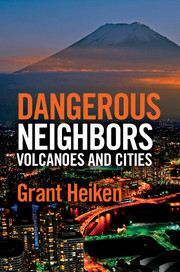Book contents
- Frontmatter
- Contents
- Preface
- Miscellaneous Frontmatter
- Introduction – dangerous neighbors: volcanoes near cities
- 1 Too many people and too many volcanoes – Naples, Italy
- 2 A full menu of volcanic hazards – Mexico City
- 3 “Like dangerous, yet undeniably beautiful women” – Guagua Pichincha and Cotopaxi volcanoes near Quito, Ecuador
- 4 Dangerous neighbors, but some bring gifts – Manila megacity, Philippines
- 5 “It’s part of the culture. Live with it!” – cities in Japan
- 6 Volcanic and proud of it – Auckland, New Zealand
- 7 Coffee, software, aircraft, and volcanic mudflows – Seattle, Tacoma, and Portland, USA
- 8 A tale of two cities – Akrotiri (island of Santorini, Greece) and Plymouth (island of Montserrat, Caribbean)
- 9 The dangerous neighbor is restless – how should a city respond?
- Recommendations for further reading
- Acknowledgements
- Index
7 - Coffee, software, aircraft, and volcanic mudflows – Seattle, Tacoma, and Portland, USA
Published online by Cambridge University Press: 05 October 2013
- Frontmatter
- Contents
- Preface
- Miscellaneous Frontmatter
- Introduction – dangerous neighbors: volcanoes near cities
- 1 Too many people and too many volcanoes – Naples, Italy
- 2 A full menu of volcanic hazards – Mexico City
- 3 “Like dangerous, yet undeniably beautiful women” – Guagua Pichincha and Cotopaxi volcanoes near Quito, Ecuador
- 4 Dangerous neighbors, but some bring gifts – Manila megacity, Philippines
- 5 “It’s part of the culture. Live with it!” – cities in Japan
- 6 Volcanic and proud of it – Auckland, New Zealand
- 7 Coffee, software, aircraft, and volcanic mudflows – Seattle, Tacoma, and Portland, USA
- 8 A tale of two cities – Akrotiri (island of Santorini, Greece) and Plymouth (island of Montserrat, Caribbean)
- 9 The dangerous neighbor is restless – how should a city respond?
- Recommendations for further reading
- Acknowledgements
- Index
Summary
. . .. we must not overlook the northwestern United States, where there are large and growing populations close to such volcanoes as Mts. Hood and St. Helens. . . . The Cascade volcanoes cannot be considered extinct. A dozen or more eruptions have taken place from them in the last century and a half, and with little question there will be more eruptions in the future.
Gordon A. Macdonald, Volcanoes, Prentice-Hall, Inc., 1972On approach to the Seattle–Tacoma International Airport, the plane descends toward very pleasant, forested lowlands broken by rolling hills, although honestly one is more likely to see little more than low-lying clouds. Many passengers are shutting down computers, some are refreshing their makeup, and some are simply daydreaming. A casual glance out the plane window can generate loud expletives from first-time visitors – as Mount Rainier suddenly looms above or just beside the plane. This massive volcano rises 14,409 feet above sea level and 8,000 feet above the mountains at its base; on clear days it simply dominates the horizon from southern Washington to the Canadian border. Many homes and institutions within the Seattle–Tacoma area are oriented to hold this impressive mountain in full view. The much-vaunted corner office is a particular prize if the building was designed with this local gem in mind.
Mount Rainier has always generated awe and respect. Native Americans of Puget Sound called the mountain Tahoma (variously translated as “snowy mountain” and “the mountain that was God”). In 1792, the British Vancouver expedition was the first to describe “a round, snowy mountain,” which subsequently was named for Rear Admiral Peter Rainier. In 1845, Captain J. C. Fremont was the first European to recognize Rainier as a volcano.
- Type
- Chapter
- Information
- Dangerous Neighbors: Volcanoes and Cities , pp. 127 - 140Publisher: Cambridge University PressPrint publication year: 2013



